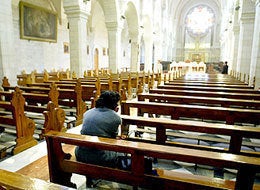
Michael Spencer, who blogs as Internet Monk, is making a splash this week with his prediction
that evangelical faith is in the midst of a major collapse. He says evangelicals will be half as numerous in two generations.
A new national study says one in three Americans is an evangelical and their numbers are growing.
Who is right? The data isn't in yet. But a closer look at that survey, the new American Religious Identification Survey (ARIS), may bolster Spencer's claim.
ARIS says one in three Americans call themselves evangelical or born again. But 38.6 percent of the people they're counting are also mainline Christians, a group that's declining fast, and 18.4 percent are Catholics.
ARIS researchers did not define born again or evangelical Christian for people answering the survey, but they note in their report that these terms are usually associated with a "personal relationship" with Jesus Christ together with a certain view of salvation, scripture, and missionary work.
Nobody knows whether the people taking the survey agree. And the ARIS report doesn't define the "certain view" they're referring to.
I'd bet Catholics don't share that common evangelical view of salvation, scripture or missionary work, which is best typified by official Southern Baptist Convention proclamations. (Neither do Southern Baptists themselves, actually but that's another point, one that Michael Spencer is all too aware of.)
As for mainline Christians, they have their own traditional, denominational ideas about what being born again or evangelical means, and it probably doesn't mean what the typical Southern Baptist means at all.
Michael Spencer doesn't base his argument on statistics. But the ARIS study backs him up if you look beyond the main headlines.
Nondenominational Evangelicals and Megachurches Aren't Saving the Faith
No one knows exactly how many people go to nondenominational churches today, which are generally evangelical, Pentecostal or Charismatic. The best guess, from a 2001 study by Hartford Institute for Religion Research, is 10 million.
Nondenominational megachurches, in particular, are often seen as the hope of the evangelical world. The ARIS report says 8 million people now go to megachurches. They saw a big increase from 1990 when they had only 200,000 members.
But only a third of megachurches are nondenominational. If those churches have 2.7 million members, their total attendance would not even begin to make up for the drop in Baptists that the new ARIS shows.
Baptists Are in Big Trouble
Baptists are by far the biggest group of evangelicals in the country. ARIS news on them is not good at all.
Fewer: Baptists, 15.8% of the U.S. population, are down from 19.3% in 1990. That's about 8 million people. Southern Baptists, the big kahuna among evangelical ranks, recorded an actual drop in total membership last year.
Grayer:
21 percent of the people who identify themselves as Baptists are 70 and older. That compares to 12 percent of the general population, 13 percent of Catholics, 14 percent of mainline Christians and 10 percent of Mormons.
Forty percent of the national population is 50 or older, while 58 percent of Baptists fall into that age bracket.
Hispanics and Asians not interested:
Baptists lost ground among Hispanics and Asians, groups they were counting on to bring them up. Seven percent of Hispanics self-identified as Baptists in 1990, compared to 3 percent in 2008. Asians were 9 percent Baptist in 1990 but now make up 3 percent of Baptists.
Plummeting baptisms (from Southern Baptist statistics)
From 1940 to 1960 Southern Baptist Convention baptisms increased by 54 percent. From 1960 to 2007 they decreased more than 10 percent.
Dropping birthrates:
The drop in birthrate that continues to decimate the ranks of mainline Christian churches is beginning to hit evangelicals, causing some of their leaders to link child bearing with God's will.
Young Evangelicals Are Deserting
I took these from blogger Sarah Burris who gathered them from reTHINK: Decide for Yourself, Is Student Ministry Working? by Steve Wright. They paint a grim picture:
•A recent TIME Magazine article points to research that found 61 percent of the adults now in their twenties participated in church activities as teens but not now.
•A study from UCLA found that only 29 percent of college students are still involved in church activities by their junior year.
•Josh McDowell estimates, 'over 69 percent of youth are leaving traditional church after high school.'
•Mark Matlock finds, 'Depending on whose numbers you use, 58 percent - 84 percent of graduating youth from church youth groups are not returning.'
•Glenn Schultz at LifeWay Christian Resources estimates that 75 percent of young people leave church in their late teens and aren't reconnecting later.
•Ron Luce in Battle Cry for a Generation estimates '88 percent of kids raised in Christian homes do not continue to follow the Lord after they graduate from high school.'
•Evangelical pollster George Barna says, 'Now only 33 percent of churched youth say that the church will play a part in their lives when they leave home.
These are yesterday's numbers. They look bad.
Michael Spencer thinks tomorrow's numbers are going to look much worse. He's probably right.